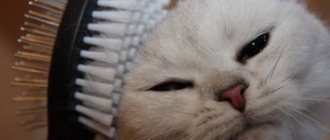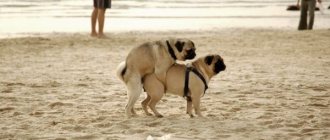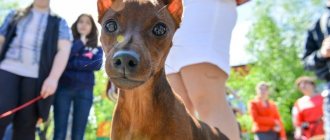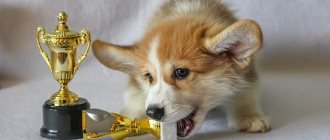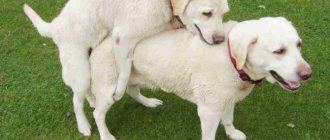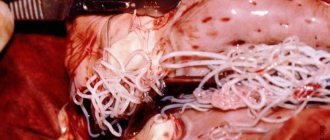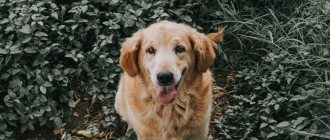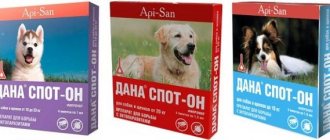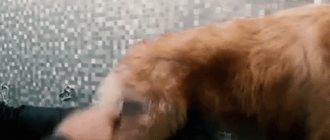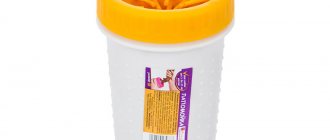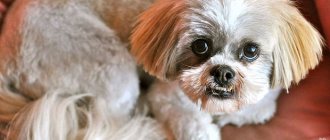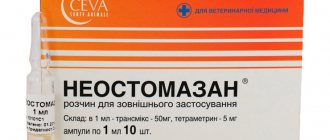If your dog has a coarse coat, to maintain its good condition, dead hairs must be removed. When they shed, they lose a small amount of fur. Dead guard hair remains in the hair follicles, preventing normal hair growth and renewal. Without proper care, after a few months the dog will look disheveled and unkempt, and mats will appear. They look ugly and create favorable conditions for harmful microorganisms (fungal infections, bacteria that cause dermatitis).
Beginning dog breeders do not always know how to trim dogs correctly and replace it with a haircut. But when shearing, the upper part of the hairs is removed. Dead base still interferes with normal hair growth. On living animals, thinner, softer hair grows, which disrupts the natural type of coat inherent in the breed. Such a dog will not receive high marks at shows. Natural protection from heat, cold and moisture deteriorates, which is dangerous for the health of the animal. Trimming is not a haircut, but a plucking of dog hair, performed with fingers or special tools.
Types of plucking
Types of trimming are divided according to the purpose of the procedure:
- hygienic - done during the molting period to remove dead hairs;
- cosmetic - done if necessary to maintain good condition of the coat;
- exhibition – held 2-3 weeks before the exhibition to increase the chances of getting the highest possible ratings.
Dog trimming is carried out in two ways:
- manual – called plaking, guard hairs are removed with fingers;
- mechanical - called stripping, guard hairs are removed with tools.
Depending on the amount of processing, trimming can be:
- light – light is done during cosmetic or show trimming, the coat is evenly thinned, removing the top layer of hairs without affecting the undercoat;
- complete - during the molting period, during a hygienic procedure, all dead hairs are removed, the undercoat is cut or plucked.
Why is it needed?
Trimming is a kind of artificial shedding. Since this process is weakly expressed in wire-haired dog breeds, dead hairs must be plucked manually or using special tools.
If this important hygienic procedure is not carried out, the top layer of the animal's coat and undercoat becomes clogged with dead guard hair. Dead hairs still in the hair follicle prevent the growth of new healthy hairs.
The fallen awn falls off and becomes tangled, disrupting the natural circulation of air and moisture, creating a favorable environment for the development of fungal infections and the proliferation of parasites.
What is dog grooming?
Preparation
Before the procedure, hygienic or cosmetic, the animal is not bathed.
Prepare the place. You need a table with a non-slip, easy to clean surface. On a slippery surface, the dog will become anxious and it will be more difficult for him to stand quietly and motionless for a long time. Salons use tables with a bracket that allows you to fix a four-legged client.
Prepare your tools so that they are at hand and you do not leave the table, making your dog nervous. Check to see if she feels well, if she is excited, and if she needs to go to the toilet.
Before the procedure, comb it, running it in the direction of hair growth, first with a wide-tooth comb, and then with a slicker brush. After completing the preparatory steps, put the dog on the table, if he is worried and tries to jump, secure him by the collar.
How does the process work?
There comes a time when it becomes necessary to trim the dog. As the fur grows, it becomes thin and brittle. This usually happens every six months. So, if you want your pet to look good and not freeze in winter, you need to trim your dog at least twice a year.
A healthy dog has dense hair that does not separate into strands. It should not look disheveled, but rather shiny. But over time, the cover loses its luster, fades, and becomes thinner. This is a sure signal that it is time to trim your pet.
For schnauzers and various terriers, the procedure is done twice a year, starting at 4 months. In some cases, they trim every season. Purebred dogs are trimmed from the age of 6 months during seasonal shedding.
In preparation for the competition, trimming is done 6-8 weeks before the exhibition. If the hair is not growing at a very fast pace, the manipulation is carried out within 10-12 weeks.
The procedure is carried out from head to tail.
- First, the back of the head is trimmed, then the sides of the neck, and then the top.
- The sides are processed from top to bottom, followed by the back.
- The hocks are the area up to which the thighs are treated.
- The shoulder blades are trimmed up to the elbow joints.
- The tail is processed from top to bottom.
Your pet may become distressed by the sound of the trimmer. In order for the dog to calm down, the procedure can be paused and continued later.
Trimming procedure:
- Disinfect the instrument.
- We place the dog on an elevated place where the procedure will be carried out.
- We comb the animal according to the growth of its fur, unraveling the fur and removing tangles.
- Using a knife, we begin trimming. First the back, then in the above order.
- We separate small tufts of hair, hold the area of skin surrounding it, and sharply pull it towards ourselves.
- We process the ears, sides, tail and limbs in random order, following our recommendations.
- When treating the head, you should first comb the dog. It is better to do the procedure on the head with your hands, constantly combing the dog and assessing its appearance.
- Treat the ears by removing hair with a machine.
- At the end of the procedure, comb and bathe your pet.
- Dry the animal's fur well, then use your hands to remove any stray hairs that you missed earlier.
Important! If the animal is nervous during the procedure, there is no need to pet it. The dog perceives this as a reward
Limit yourself to a light massage, distracting your pet.
Required tools and materials
If you are planning to contact a specialist or a salon for trimming, there will be no need for your tools and consumables.
But if you decide to try yourself as a groomer, you will need:
- Trimming knife.
- Comb.
- Scissors.
- Hair clipper.
- Finger pads or rubber gloves.
- Talc powder.
You can take a ready-made knife, or you can make it yourself. A slightly sharpened knife or a piece of a hacksaw equipped with something like a handle will do.
If you do not have enough experience, you should not use sharp scissors at first. It is better to take a thick comb made of metal
In general, it is worth saying that the quality of the dog trimming tool is extremely important.
Trimming done with a good tool is not much different in quality from completely manual trimming.
Hair plucking
During the procedure, scissors are used only for hygienic cutting. Everything else is done with hands and a knife. There are very few craftsmen who do everything in full accordance with the rules, and their services are very expensive.
Manually plucking dead fur, without using any tools, is considered a manifestation of the groomer's highest qualifications. This is a very labor-intensive and lengthy process.
Its advantages compared to the traditional procedure using a knife:
- The wool does not break.
- This trimming is better tolerated by the animal itself.
Plucking
Carefully inspect the animal for mats. They often form under the chin, on the stomach, under the paws, and at the base of the tail. Any tangles found should be untangled with your fingers and combed with a flat comb. If you can’t untangle them, take a tangle cutter and cut them off.
After untangling or cutting out the tangles, begin plucking the guard hairs, moving from the back of the head to the tail. When plucking by hand, grab a few hairs with your index finger and thumb and lightly tug them in the direction of growth. If you use a knife, you need to grab the strand with the tool and press it with your thumb. Using the fingers of your other hand, stretch the skin around the treated area and sharply lift the knife diagonally (up and in the direction of hair growth).
After removing dead guard hair from the back, sides, and tail, proceed to processing the hips and shoulder blades. Lastly, they work on the head and muzzle. These sensitive areas are not stripped, but the hairs are plucked manually in small bunches. After treatment, the animal needs to be bathed, and when the hair is dry, remove any loose hairs that stick out with your fingers or tweezers.
Features of the procedure
Trimming dogs is a long-term procedure (can take 4-6 hours), requiring skills, knowledge, and experience. But, if you wish, you can try the procedure at home. To do this, you should know some rules and features of its implementation.
How to do it and in what order:
- the back of the head, the sides of the neck and only then the upper part;
- sides, from top to bottom;
- back;
- shoulder blades, from top to bottom to the elbow joints;
- hind limbs (hips) to the hocks;
- the tail is plucked from top to bottom;
- ears and paws can be processed in any order.
It is very important to comb your pet well before the procedure in order to see what hair needs to be removed. During the trimming process, periodically comb the fur with your fingers, as if ruffling it, to evaluate the result and see possible flaws
Don't try to remove as much hair as possible at once. This will not shorten the procedure, but may make the dog feel uncomfortable. Separate small tufts and press the wool tightly against the knife. The skin around the bun should be held with your free hand, pressing lightly. You need to pull the fur sharply, with force, strictly towards yourself. After treatment, the dog must be washed, dried well and combed. This way you can see flaws in the work, if there are any, and correct them as much as possible.
There is an opinion that trimming is a painful procedure. Although professional groomers claim that this is not entirely correct. The fur being removed is already dead, so there is no pain when plucking it, although discomfort may be present. Dogs who are not yet familiar with this procedure may show some anxiety. Therefore, it is enough to stop for a while and calm the animal.
What dogs are trimmed?
Trimming for dogs is necessary for animals with coarse guard hairs. Their distinguishing feature is that they shed lightly. Trimmed breeds are terriers (fox terrier, airedale terrier, scotch terrier, jack russell terrier), schnauzers (middle schnauzer, miniature schnauzer, giant schnauzer), Brussels and Belgian griffons, Vendean basset griffon, wire-haired dachshunds. These are hunting dogs that find, drive, and bring game, making their way through dense forest thickets. The dead fur remains on the branches, and they do not require additional care. But many dog breeders buy puppies of these breeds without planning to regularly go hunting. Instead of dense forest thickets, they walk along city streets, and natural trimming does not occur. And the owner must help the dog keep his coat in order.
English and American Cocker Spaniels, Irish and English Setters need partial trimming on certain parts of the body where the guard hair is coarser.
How often and at what age should hair be plucked?
The age of the first trimming of dogs and its frequency depend on the characteristics of the breed. Brussels or Belgian griffins are trimmed for the first time at three months, and schnauzers - no earlier than 6-9 months. When buying a hunting breed puppy, check with the breeder whether he needs trimming, at what age and how often. If plucking is done too early, the coat may become thinner. It will be difficult to restore the damaged coat, and the dog will not receive high marks at shows.
You also need to know the optimal timing for exhibition trimming. For terriers, dachshunds, griffins - this is 1.5-2 months before the exhibition, for schnauzers - 2-2.5 months. But due to the individual characteristics of the dog, these terms may vary.
When is trimming done?
The first time the process occurs when the puppy is six months old or a little less. The time of molting is favorable for this (spring and autumn). Next time you can pluck after 6 months. During this time, the coat will have time to renew itself, and the old hairs will die off. There are some nuances regarding individual breeds, but on average the frequency is the same.
The time for pinching can be easily determined by the appearance of the four-legged animal. The cover begins to bristle and looks sloppy. The hairs become thinner and stick out in different directions. You can run your hand against the grain, if something remains on your fingers, the time has come.
Interesting: plucking improves the quality of the coat. New hairs grow thicker and shine. For an exhibition, for example, you need to pluck once every 2 weeks so that the coat is renewed, thicker and looks presentable.
Combs
To care for coarse hair, you need to use several different combs. To comb the fur on the head and paws, use a metal comb with sparse teeth. They use it to comb the dog before and after trimming. The sparse teeth carefully remove hairs without pulling out or injuring living hair or causing pain to the animal. This comb is also convenient to use for untangling tangles.
A long-toothed rake comb is needed to remove dirt and dead hair between pluckings; some groomers also use it for trimming. To care for the undercoat, you need a slicker brush with short, thin teeth arranged in several rows. But when choosing what to trim a dog with, owners and groomers prefer trimmers. Models are available for large, small and medium breeds, short-haired and long-haired.
Did you know that you need a special tool to trim hair in your ears and head? Here you can choose a high-quality accessory with a comfortable handle:
Quick view
TRIXIE frequent trimming with vinyl handle, 19 cm (1 piece)
1 PC
773 ₽
Show all offers
Difference from haircut
Most owners of wire-haired breeds who do not take part in dog shows do not consider it necessary to trim their animals and limit themselves only to combing and trimming mats. In fact, this is a wrong opinion. Haircut and trimming are different procedures that are different and have different purposes, do not confuse them. Haircut cannot be an alternative to hair plucking, since its main function is only aesthetic, while trimming is a hygienic procedure.
If coarse hair is not removed mechanically, but only trimmed, over time the coat will lose its attractiveness: it will become very soft, sparse, and dull. The main reason for this is the structure of the hair: it is thick at the end and thin near the base. After trimming, instead of the old hair, the same hair grows back, and when trimmed, it will continue to grow from the thin base that remains.
Regular trimming will ruin the structure of the coat, thinning and discoloring the hair, especially if the animal is periodically shaved bald. The wool gradually begins to become “cotton” and soft to the touch , does not retain its shape, quickly gets dirty, falls off, and gets wet.
Restoring the hair structure after regular haircuts is difficult and most often impossible. Only a professional groomer can correct the situation. After trimming, the quality of the hair will improve slightly, but it will no longer be perfect.
Knives
The main tool when performing stripping is special knives with small metal teeth at the end. Small tufts of dead guard hairs cling to them and are removed with a sharp movement. To prevent the knife from cutting off live fur and damaging the skin, its edge and teeth are dull.
Groomers use four types of knives when plucking dogs:
- Coarse - at the end is a small brush with short, thick, blunt teeth made of stainless or tool steel, used when working with large breeds with hard hair or if the trimming period is missed, there is a lot of matted dead guard hair.
- Medium - the brush shape is the same as Coarse, but the metal teeth are thinner, used for treating the back and sides.
- Fine or Extra fine – the teeth are even thinner and slightly shorter, used for plucking outer hair on the neck, head, and ears.
- Face is a serrated knife with a short, rounded working part, needed for painlessly removing dead hair on the face.
Sometimes master groomers use stone knives for trimming. Their working part is covered with abrasive material and tapered towards the edge. With their help, you can carefully, without causing pain to the animal, remove dead guard hair in hard-to-reach places - near the anus, in the groin, on the ears and face. Stone knives are also convenient to use when processing the back, sides, and paws; they do not injure the skin or damage living hairs, but working with them requires skill; it is difficult for novice groomers without an experienced mentor to master them on their own.
Advice
Trimming in dogs is a long, painstaking and expensive procedure. The choice of a master must be approached responsibly and seriously. Consult with the breeder or dog lovers you know. The final result of plucking depends not only on the professionalism of the groomer, but also on his ability to establish contact with the “client”. A regular procedure should not turn into stress for the dog and an endless search for “his” master. You should not take risks and trim yourself if you do not have any experience. You risk causing pain to your pet and ruining its appearance.
